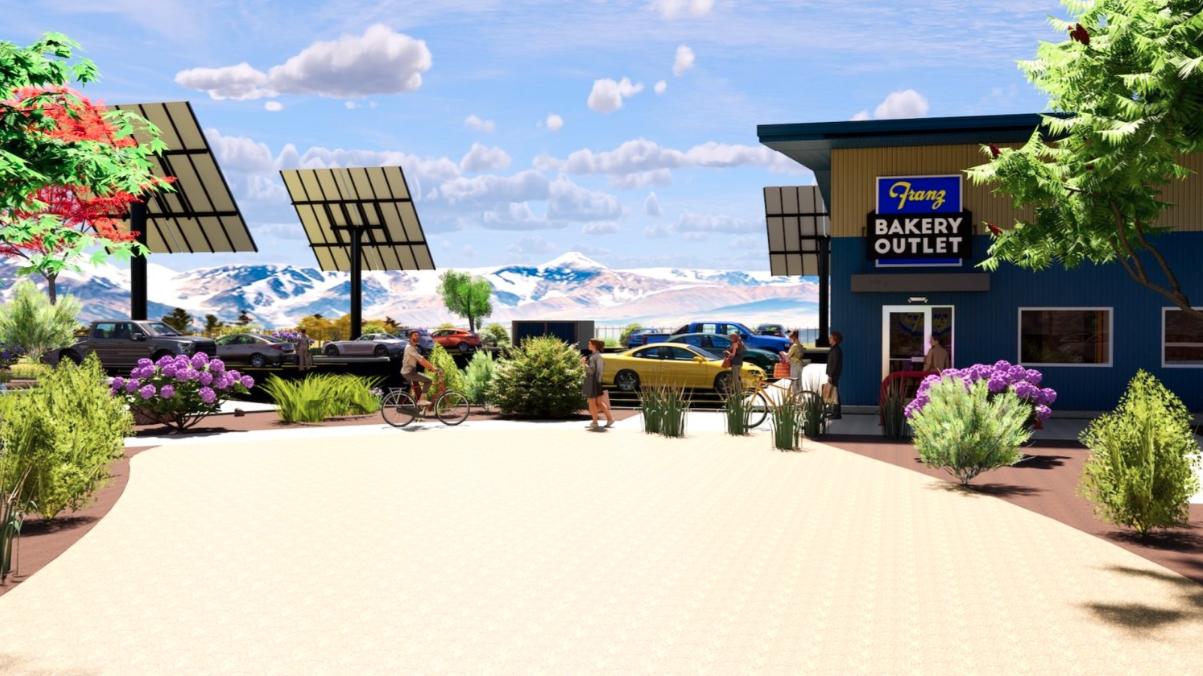
23 minute read
Franz Bakery partners with Stracker Solar to make new facility Net Zero electric
Six elevated Strackers will power new Franz Bakery Outlet Store and Depot in White City, producing 170,000 kWh clean solar energy per year
Ashland’s Stracker Solar was chosen to design and build a state-of-the-art solar installation for Franz Bakery’s new Outlet Store and Depot in White City, utilizing their unique elevated dual-axis solar trackers. The sixStracker installation in the parking lot will make the new location net zero electric (offsetting all the facility’s power needs), while accommodating possible future EV charging stations.
Advertisement
“Franz is proud to support sustainability energy efforts in partnership with Stracker Solar at our new White City Outlet Store and Depot location”, says Mike Petitt, Chief Financial Officer at United States Bakery (DBA Franz Bakery). “We continually seek opportunities to reduce energy use – the solar trackers at this location will provide an optimal solution to reduce energy costs and support climate action in the community.”
Prime contractor JB Steel is leading the construction of the 21,000 sq. ft facility and its premises.
“With the increased demand for green energy, we felt it was important that we have the ability to include solar generation into our projects”, said JB Steel Project Manager Alex Batzer about the time when the company first started conversations with Stracker Solar. “Bringing our clients best-in-class solutions is an essential part of how we do business, and solar is no exception. We chose to partner with Stracker Solar because of their unique product that is not only perfectly compatible with parking lots but also the most efficient PV system available.”
“We are thankful to JB Steel and Franz Bakery for choosing us for this project”, says Jeff Sharpe, Founder and CEO of Stracker Solar. “It is a great example of businesses working together to bring more energy resilience and sustainability to our local communities. Which is what Stracker Solar is about.”
As the need for solar energy continues to increase in both
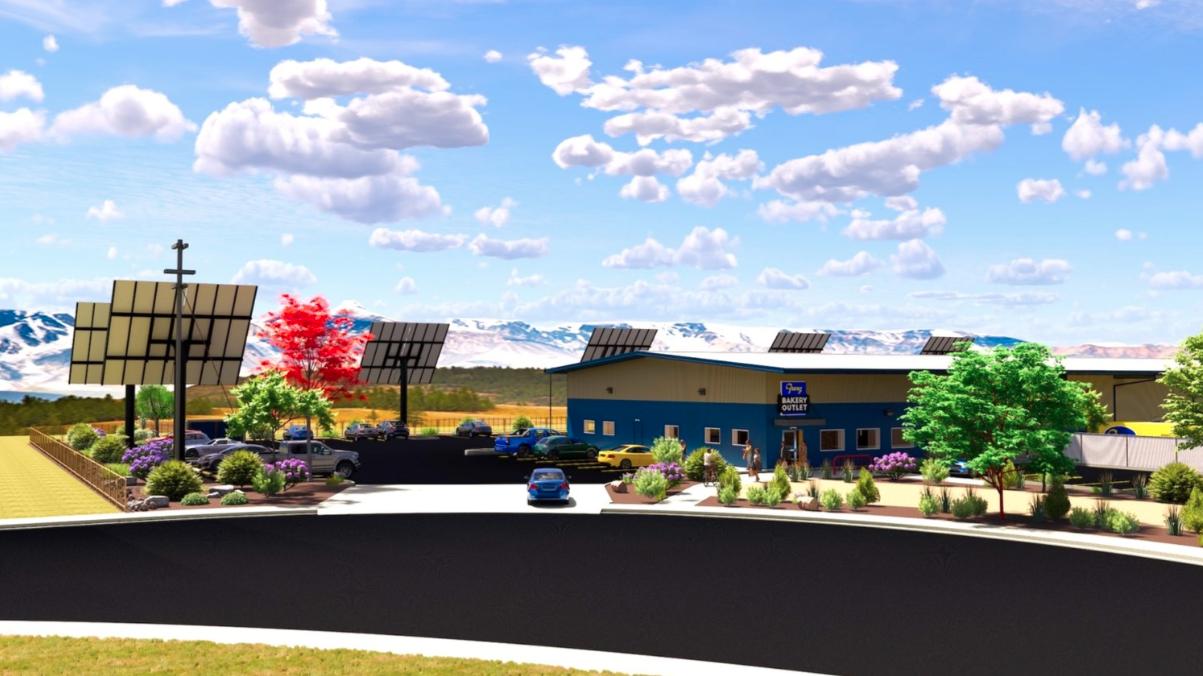
the commercial and public sectors, renewable energy professionals expect greater demand for solutions like the elevated Strackers that maximize solar energy production with the smallest footprint. “Giving up large areas of valuable land for solar generation is not a viable path for most communities. For true sustainability, we need to preserve land use while generating as much clean energy as possible,” says Sharpe.
JB Steel started site work on the premises in January 2022 with the installation of the solar trackers planned for early June. We expect the full completion of the project around mid-summer 2022. We hope the local community will be excited about the brand-new Franz Bakery Outlet Store and Depot that is 100% powered by the energy of the sun.
About Strackers:
– By following the exact position of the sun throughout the day, Strackers generate 50%-70% more solar energy than same-sized rooftop solar, carport or fixed ground mount systems. This efficiency translates to a 55%-65% lower carbon footprint as well.
– Stracker’s 20′ pole-mounting allows continued use of the grounds below with no need for fencing.
– Strackers are developed and manufactured in Ashland by Stracker Solar and are documenting unparalleled performance across a variety of northern California and southern Oregon climates.
– Strackers are the only dualaxis trackers that carry the valued UL 3703 listing (proof of compliance with the highest electrical and mechanical engineering standards) and qualify for Energy Trust of Oregon incentives.
1 https://www.epa.gov/ energy/greenhouse-gasequivalencies-calculator
strackersolar.com
By Marshall Doak, SOU SBDC Director
With the thought that emerging out of the COVID Pandemic business shutdowns we have a different economic environment and feel than when we went in, I have been reading an interesting book that offers alternate advice on how to move forward with a fresh outlook to problem-solving.1 Written prior to the Pandemic, it nonetheless offers interesting viewpoints to conventional thinking regarding how to succeed in business today. If you are wanting a different view into conventional wisdom, this book is a great place to start.
It does help to be in an industry that has the ability to print millionaires by the dozens in a rapid manner, such as Jason and David are in. Being the originators of Basecamp, a project management software with wide acceptance, explains the rapid growth of their company, and also affords the two the ability to stand on the pulpit and deliver wisdom to the rest of us by virtue of their success. As a teaser, a few items of wisdom that aren’t necessarily mainstream contained in the ‘ReWork: Change the Way You Work Forever’ book:
“That would never work in the real world” is commonly heard with counsel to not listen, rather: “The real world isn’t a place, it’s an excuse. It’s a justification for not trying. It has nothing to do with you.”
“Scratch your own itch” meaning “The easiest, most straightforward way to create a new product or service is to make something you want to use. That lets you design what you know…”
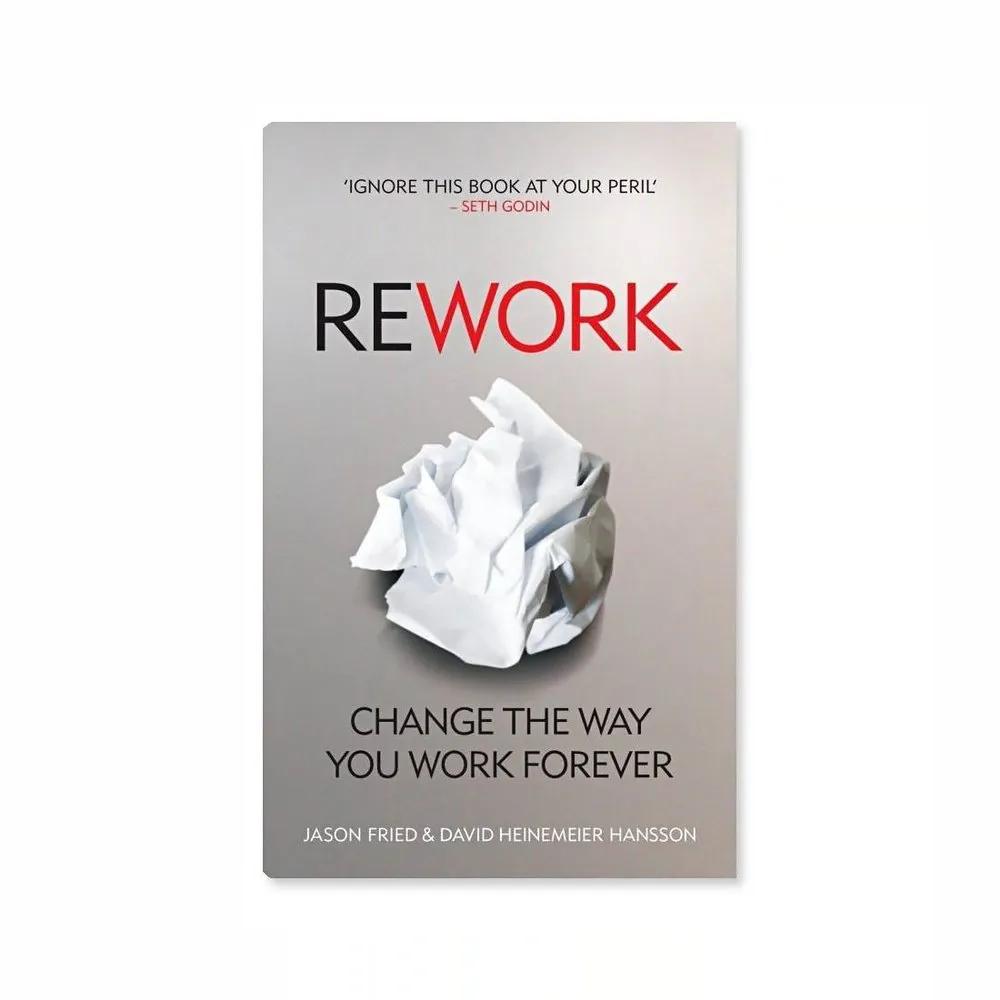
“Less is a good thing”, or
“Embrace constraints”. “Less is a good thing.
Constraints are advantages in disguise. Limited resources force you to make do with what you’ve got. There’s no room for waste. And that forces you to be creative.”
“Decisions are Progress”. Avoiding decisions create problems. “The problem comes when you postpone decisions in the hope that a perfect answer will come to you later. It won’t. You’re as
ReWork Your Business
likely to make a great call today as you are tomorrow.”
Look for “Quick Wins.” I think this can be used by many businesses that are slow to react. “Momentum fuels motivation. Without it, you can’t go anywhere. To keep your momentum and motivation up, get in the habit of accomplishing small victories along the way.”
One of the things I like about ReWork is the individual thoughts are independent of each other and are arranged as stand-alone papers. The net result for me is that I do not have to dedicate time to read, rather casually picking up the book and leafing through it to interesting thoughts works well with the book’s format.
It is important to have outside sources of information to your company so that you can import the best practices you are able to find in order to improve your operations. Keeping up with technological advances, with advances in systems integration, and with the best thoughts and counsel mentors can provide will keep you and your company competitive. Here is something to think about: For the next few months, try looking at your systems, setting goals, accomplishing small wins and recognizing those who have made these victories possible. The celebrations will build team spirit and improve you company’s performance. Set a goal. If you are not celebrating victories on a regular basis by the end of July, make a vow to seek and find competent counsel on how you can apply positive incremental changes to your business. Start with a set of goals, develop a strategy for fulfilling those goals, and then execute the plan while measuring your progress.
I’ve been spending some time this past year working with businesspeople who are preparing to exit their businesses and want to retain the value in the company to capitalize on the hard work spent over the years or decades building the company up. In some cases, the amount of work required to bring the company up to an acceptable, marketable level can be overwhelming. It takes time to institute the needed changes and to get them to integrate in order to work systems training into the company. This implies that a person needs to start well in advance of retirement building the company into a sellable entity.
In many cases, the work required to bring company to be best in class for sale are the same tasks that could be performed over the years previously at a leisurely pace. The advantage of building over time is that the costs are absorbed along the way and the profits are enjoyed for more years than what they would be after a late minute dash just before listing time.
Make the decision to get your business in order and enjoy the benefits for the years you have it!
Remember……………… “Decisions are Progress”.
1Fried, Jason and Heinemeier Hansson, David. (2010). Rework: Change the Way You Work Forever. Vermilion.
—Marshall Doak is the Director of the Southern Oregon University Small Business Development Center and a huge supporter of innovation and the community that forms around innovation in the economy. In private practice, he works with businesses that plan to transition to new ownership within the next five years, assisting them to build value that can be converted to retirement income when the business sells. He can be reached through: mdoak06@gmail.com or 541-646-4126.
By Press Release
Siuslaw Pioneer Museum Receives Critical Funding From Bonneville Power Grant Through Florence Area Chamber Of Commerce
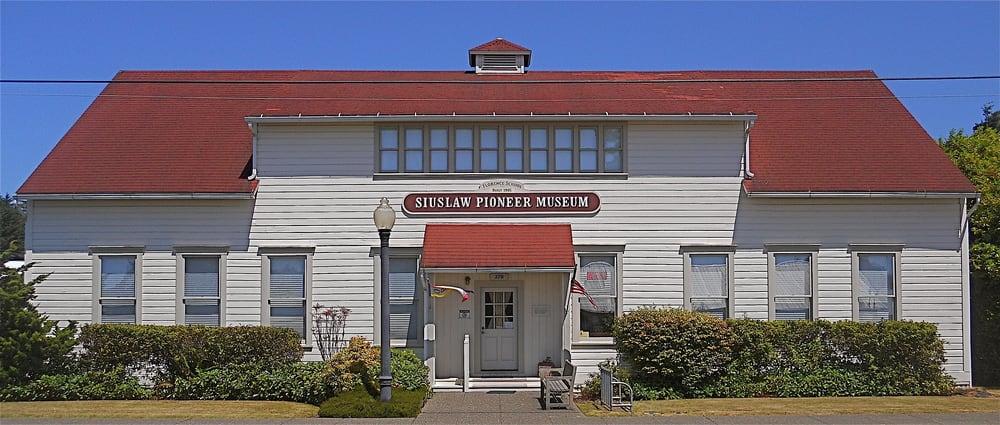
Lifelong Florence resident Del Phelps has had a fear that kept him up at night. But he’s sleeping a little better these days. “An orange glow shows from the window. Soon, it radiates out another. And another.
Before the neighbors can call 911 the entire library wing of the Siuslaw Pioneer Museum is engulfed in a roaring inferno spreading unimpeded into the main building with all its priceless artifacts. The fire department arrives in time to evacuate the block and save… almost nothing,” explains Phelps of his nightmare. Phelps, a direct descendant of Siuslaw region pioneers, local real estate professional, and avid community volunteer, currently serves as the museum’s board president. Local history, and the preservation of it, is his passion.
Today Phelps and the museum’s volunteer board of directors are sleeping sounder and have nearly 88,000 reasons to celebrate.
They set an $88,000 goal for a fire suppression system for both museum buildings and the porch area: $41,000 for the system itself, $25,000 to connect the building to a city water main, and another $14,000 to $15,000 for permits, delays, and some for possible overruns common to projects of this size. “That’s why the board budgeted $88,000 for its Artifact Preservation Initiative,” he explained. Phelps took action and secured a $20,000 private matching grant from a consortium of local families who share his passion for preserving Florence’s past. Other board members went to the community and raised nearly $23,000 to meet the match. Board member Cindy Gentry started applying for grants, gaining an Oregon Heritage grant of $20,000.
Bob and Kay King made a personal contribution of $5,000. In total the group raised nearly $78,000 in three months to preserve the area’s treasure trove of history. But it was a $10,000 grant from the Bonneville Power Administration, gained through a collaboration of Susy Lacer, local professional grant writer, and Bettina Hannigan, president/ CEO of the Florence Area Chamber of Commerce, in connection with Tama Tochihara, Senior Historian at Bonneville Power Administration that helped push the group over the top to reach their goal. “We were able to leverage this grant with BPA for use in Florence, and the Chamber recommended the Museum and its fire suppression needs as the recipient. The Chamber asked for and received the grant to protect our community’s historic treasure trove,” said Hannigan.
“Thank you to our dedicated board, key community friends, museum operations manager Harry Zinn, Bettina, Susy, and the Bonneville Power Administration foundation, we’re there; the work on the fire suppression system has already begun,” reported Phelps. “This incredible investment in the museum’s safety and preservation of priceless and irreplaceable artifacts protects this historic building, items brought across the Oregon and Applegate Trails, prized pieces from local first-nations people, industry
and household implements from the 1800’s, and archives of directories, yearbooks, and newspapers. Those treasures are an investment in the greater good of this community’s shared story and identity,” he added.
Those wishing to contribute to the museum’s general fund for new acquisitions, preservation, and maintenance can do so online at SiuslawPioneerMuseum.org, by mailing a check to the Siuslaw Pioneer Museum, PO Box 2637, Florence 97439, or by dropping off a financial gift at the museum, 278 Maple St. Contributions of $20 or more come with annual passes to the museum. To learn more about the Siuslaw Pioneer Museum, its exhibits, hours, membership, tours, and admission, visit
SiuslawPioneerMuseum.com
or call 541-997-7884.
About the Museum: Visitors to the Siuslaw Pioneer Museum are transported through time by a diversity of exhibits showing slices of life from before white settlers made their way to the Siuslaw Region and up to life in the 1950s. On display are two floors of displays featuring items from an authentic dug-out canoe, and firstpeople’s tools and apparel, to household items of pioneer homesteaders; from early logging and fishing implements to the control panel once used by the drawbridge operator; and one of the first telephone switchboards. Visitors will learn about the hardscrabble life of those who started the logging and fishing industries around Florence in the mid- to late-1800s and see examples of the delicate side of life through the place settings and handiwork of talented lace and quiltmakers.
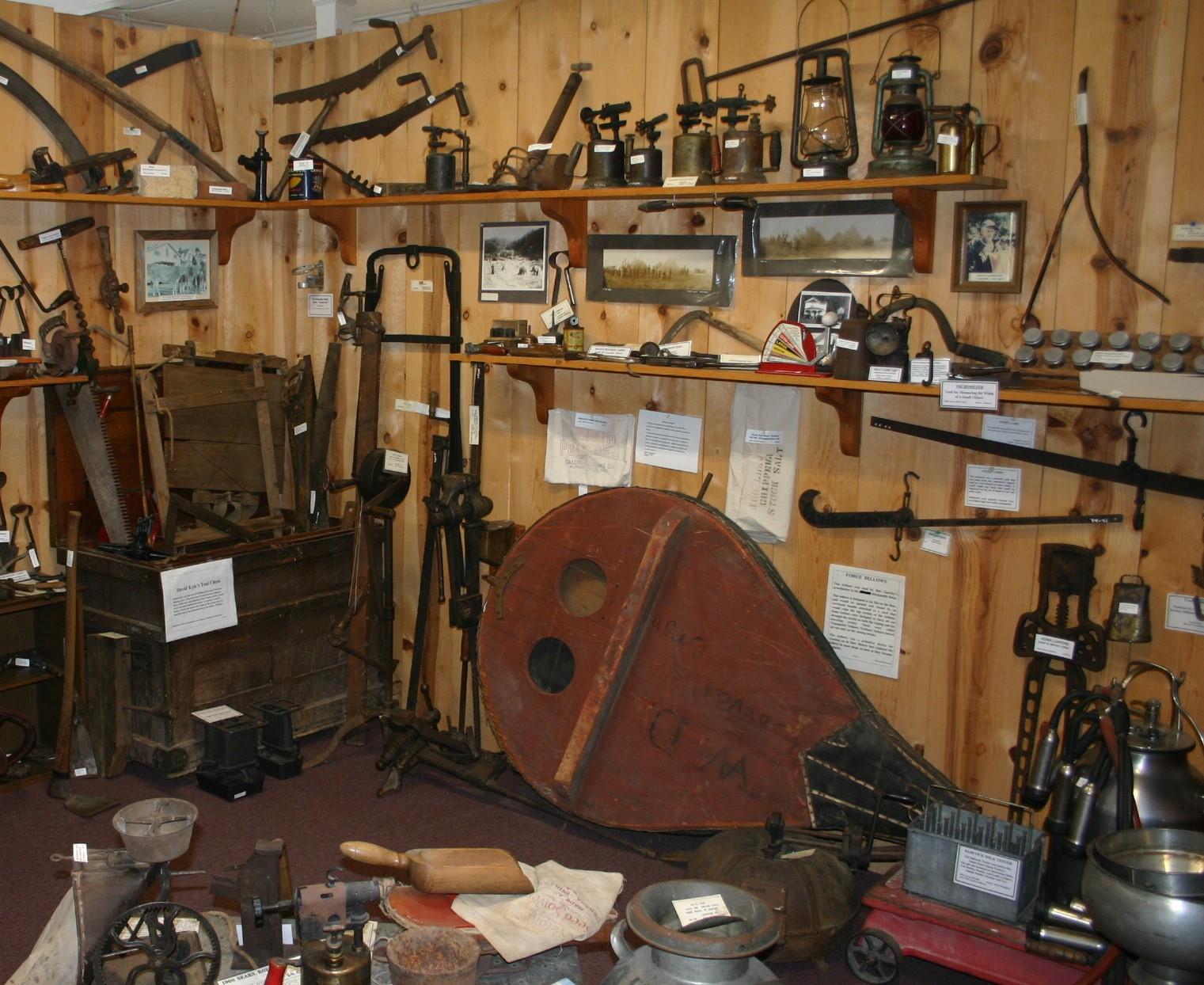
By Press Release
KFDA Awarded $200,000 Revitalization Grant to Support Rehabilitation of the Arcade Hotel
he Klamath Falls Downtown Association (KFDA) announces today that it has received an Oregon Main Street Revitalization Grant (OMSRG) in the amount of $200,000 to support the rehabilitation and reopening of the Arcade Hotel in Downtown Klamath Falls.
Forefathers Capital, an investment and development group that includes a Klamath Falls resident, completed its purchase of the property on May 31 and will begin work to restore the property back to its historic use as a hotel. The group owns other properties in the Klamath Falls area and has experience in developing hotel properties and working with historic buildings. The grant will provide capital for the initial stages of a multimilliondollar renovation effort expected to be completed in 2023. When complete, the property will be reopened as a 22-room boutique hotel.
“This will be a transformational project for downtown Klamath Falls and represents the first significant historic preservation project in Downtown Klamath Falls in over two decades” said Darin Rutledge, KFDA’s executive director. “The historic Arcade Hotel has been vacant for a number of years and we felt that it was running out of chances for any meaningful preservation opportunities.” Robbie Janda, spokesperson for Forefathers Capital, relayed his team’s enthusiasm for the project. “We are thrilled to have been given the opportunity to revitalize such an important landmark in
Downtown Klamath Falls. The
OMSRG was an essential part of getting this project off the ground, and without it another piece of history would likely have been lost. A special thanks to KFDA for their expertise in helping build out this complex capital stack and consulting on downstream incentives. We’re looking forward to a continual partnership with KFDA as we endeavor to return the Arcade Hotel to prominence on Main Street.”
KFDA evaluated a number of potential projects to include in its grant application, but the Arcade Hotel stood out as the project that would be most competitive. “This project checks all the boxes that this grant program is built on – saving a historic building, catalyzing community investment, creating jobs, increasing property value and tax revenue, and creating vibrancy in our downtown. It will also provide a new lodging product that is unique in Klamath County,” said Kendall Bell, Chair of KFDA’s Design Committee and grant writer.
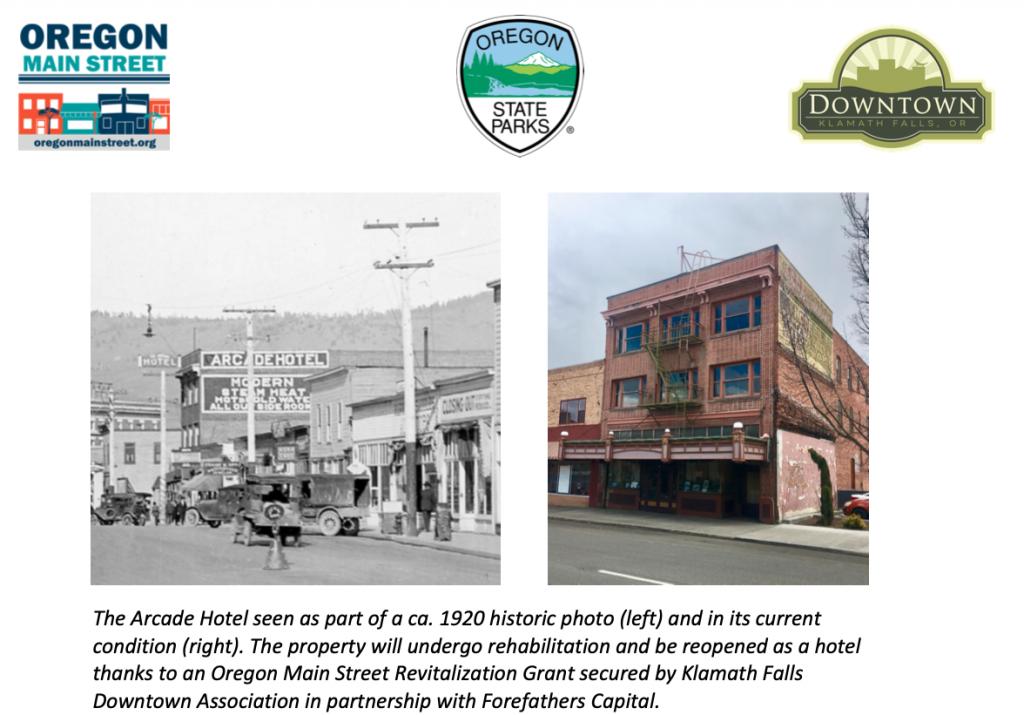
The Oregon Main Street Revitalization Grant Fund was authorized by the Oregon Legislature in 2015 to provide capital to stimulate downtown revitalization projects around the state. It was first funded in 2017 with a $2.5 million allocation, which was increased to $5 million in 2019. The fund was replenished with a $10 million allocation in 2021 to support a “catch up” cycle for 2022 and the regular grant cycle in 2023. Creation of the fund and its succeeding allocations are the result of grassroots advocacy efforts on behalf of Main Street organizations such as KFDA around the state. Bell, one of KFDA’s founding members, was instrumental in the creation of the fund in 2015, testifying in Salem on multiple occasions throughout the legislative process.
Grant awards are made every two years in odd years, although the allocation in 2021 included an additional $5 million for 2022 since the allocation was postponed during the pandemic. KFDA has received a grant award in all three cycles to date. Grants in 2017 and 2019 supported upper floor redevelopment projects that resulted in 25 new residential units in Downtown Klamath Falls. The Oregon Main Street Revitalization Grant is administered through the Oregon Parks & Recreation Department’s Oregon Heritage division and is available only to local organizations affiliated with Oregon Main Street. Eligible projects, which must be located within an Oregon Main Street district, include rehabilitation/ renovation of existing properties, compatible new construction, and in some cases, purchase of existing properties.
“We’re obviously thrilled to have received this grant three cycles in a row,” said Rutledge. “It speaks to the support of our community for its downtown and aligns with our mission to strategically balance the need for economic vitality with the desire to preserve the historic character of our downtown. We are excited to work with Forefathers Capital to further that mission and to catalyze additional investment in Downtown Klamath Falls.”
About the Oregon Main Street
Revitalization Grant: The grant program was created during the 2015 legislative session and placed with the Oregon State Historic Preservation Office. The legislation established a permanent fund for the Oregon Main Street Revitalization Grant and provided an initial infusion of funds from the sale of lottery bonds. The legislature included the Oregon Main Street Revitalization Grant in the lottery bond package approved in 2017. The funds must be used to award grants to participating Oregon Main Street Network organizations to acquire, rehabilitate or construct buildings to facilitate community revitalization. The program also requires that at least 50 percent of the funds go to rural communities as defined in the bill.
About KFDA:
Klamath Falls Downtown Association (KFDA) is an accredited member of the National Main Street Center and Oregon Main Street programs and is an IRSapproved 501(c)(3) nonprofit organization. Among many principles, KFDA believes in downtown revitalization, historic preservation, shopping local and supporting the small businesses that are the cornerstone of our community. Every day, we advocate on behalf of not only the downtown merchants, but the community as a whole so that our rich history is preserved, and future generations are proud to call Klamath Falls home. The work of KFDA is made possible in large part by the contributions of its Major Supporters. ChampionLevel Supporters: Amerititle; Fairfield by Marriott Inn & Suites; Fisher Nicholson Realty; KCEDA; KLADFM92.5; Klamath County; Klamath Insurance Center; Oregon Tech; Pacific Power; SmithBates; The City of Klamath Falls; Tillberg Studio & Gallery. And Promoter-Level Supporters: Discover Klamath; NIS Labs; Thai Orchid; Holiday Market; Rodeos Pizza & Saladeria; The Residences@621; Bell Hardware; Craft3; Klamath County Association of Realtors; Klamath County Developmental Disabilities Services.
Published at: https://www.qualityinfo.org/-/oregon-s-leisure-and-hospitality-industry by Guy Tauer Oregon Regional Economist Coos, Curry, Jackson, and Josephine counties
Oregon’s Leisure and Hospitality Industry
Leisure and hospitality businesses employed 174,800 workers on average in 2021, up from 162,100 workers in 2020. Of those, roughly one out of nine were employed in accommodations, about the same as in arts, entertainment, and recreation. About threefourths of leisure and hospitality workers worked in food services and drinking places. These annual average figures mask how the COVID-19 pandemic has disproportionally impacted this sector of the economy. In spring 2020, mandated closures or curtailments for entire business categories, as well as changing consumer spending patterns in response to the pandemic, resulted in massive job loss in just a short time.
From February 2020 to April 2020 the leisure and hospitality sector shed 52% of payroll employment, compared with a loss of 14% across all Oregon industries. Consumers quickly changed food buying habits under the Stay Home- Save Lives mandated closures, and much of the population was in a hunker-down mentality as the pandemic swept in. Leisure and hospitality had 216,500 jobs in February 2020 and by April 2020 employment fell to 104,400, essentially erasing the industry’s previous 30 years of job gains. Of the 282,000 payroll jobs Oregon lost during that time, 112,100 of those, or nearly 40%, were in the leisure and hospitality sector.
Now two years into the employment recovery from the depths of the pandemic recession, the leisure and hospitality sector has recovered just 83% of the jobs lost, compared with 88% for the all-industry average. Leisure and hospitality is down 19,400 jobs compared with prepandemic employment, or 9% below its peak. Nationally, data from the Census Bureau’s new Business Pulse Survey continues to show the leisure and hospitality component industries of arts, entertainment, and recreation, and accommodation and food services reporting the highest share of businesses stating the COVID pandemic has had a large negative impact on their business. During the most recent week of the survey from April 11 to April 17, 44.7% of accommodation and food services businesses reported the pandemic having a large negative impact on their business. About one-third of arts, entertainment, and recreation businesses said they were also experiencing a large negative impact due to the pandemic, compared with the all industry average of 21.6%. However, this is an improvement from two years ago when more than three-quarters of leisure and hospitality businesses
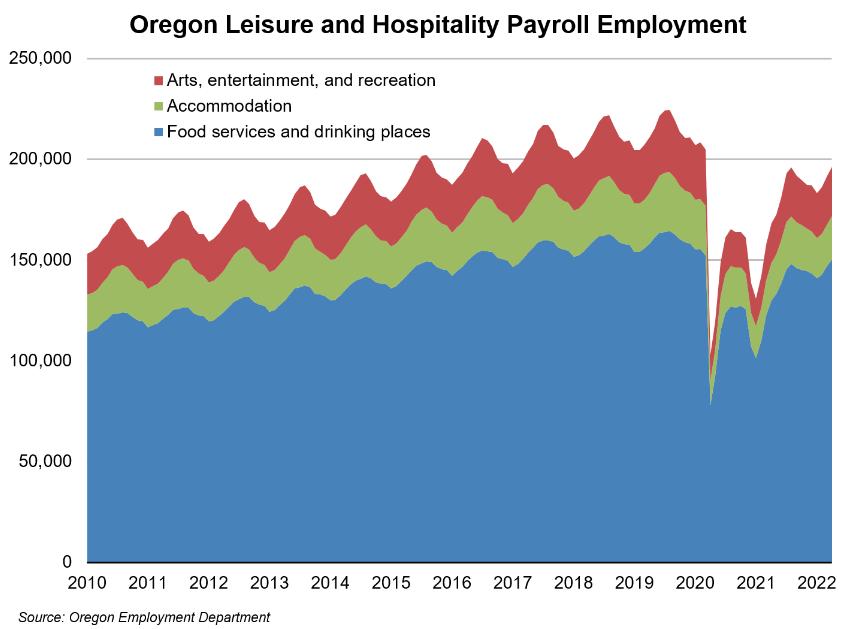
reported that the COVID-19 pandemic had a large negative impact on their business. One surprise finding from the Census Business Pulse Survey was that the pandemic was reported by about 7% of accommodation and food service businesses to have had a moderate or large positive impact on their businesses. More can be found at https:// www.census.gov/data/ experimental-dataproducts/small-businesspulse-survey.html.
The saw-toothed look on the graph shows the seasonal nature of work in this tourism-related industry, as well as the precipitous declines and recovery seen in the past two years. During the Great Recession, employment in this industry fell by 6.1% from 2008 to 2010. Oregon’s all-industry employment decline was slightly steeper, with payroll jobs declining by 7.4% from pre-recession peak to trough. By 2018, leisure and hospitality employment rose by 30.1% compared with a gain of 19.3% for total industry employment. As of February 2020, the month before the pandemic hit our economy in earnest, leisure and hospitality was still showing modest over-the-
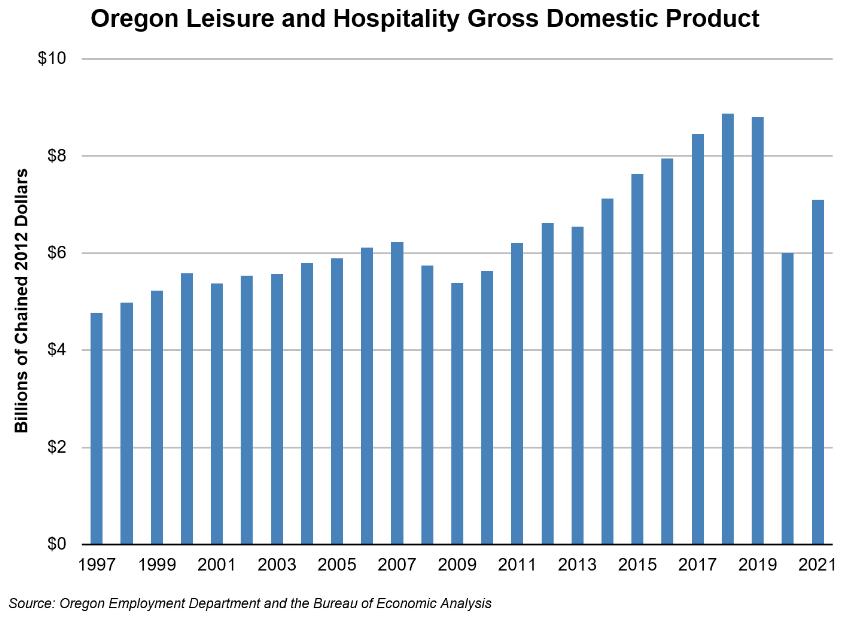
year job growth, rising by 1.8% (+3,700 jobs). Over the most recent 12 months ending in April 2022, the arts, entertainment, and recreation industry gained 4,600 jobs or a gain of 23.2%. Accommodations added 3,000 job, an increase of 16.1%. Food services and drinking places employment increased by 20,200 jobs statewide, a gain of 15.5%. Within the food services component, the gain was uneven with full-service eating places up by 11,000 jobs or 20.7% and limitedservice eating places gaining 4,400 jobs, a slower increase of 6.7%. Full-service restaurant employment fell more sharply early in the pandemic than limitedservice establishments.
One blessing in disguise occurred during the pandemic when the Almeda, Obenchain, and Slater fires hit Southern Oregon. Many of those who were evacuated or lost homes were able to find temporary or long-term shelter in the area’s hotels and other lodging places. Had it been a normal non-pandemic summer near the peak of tourist season, it is likely that many of those hotels would
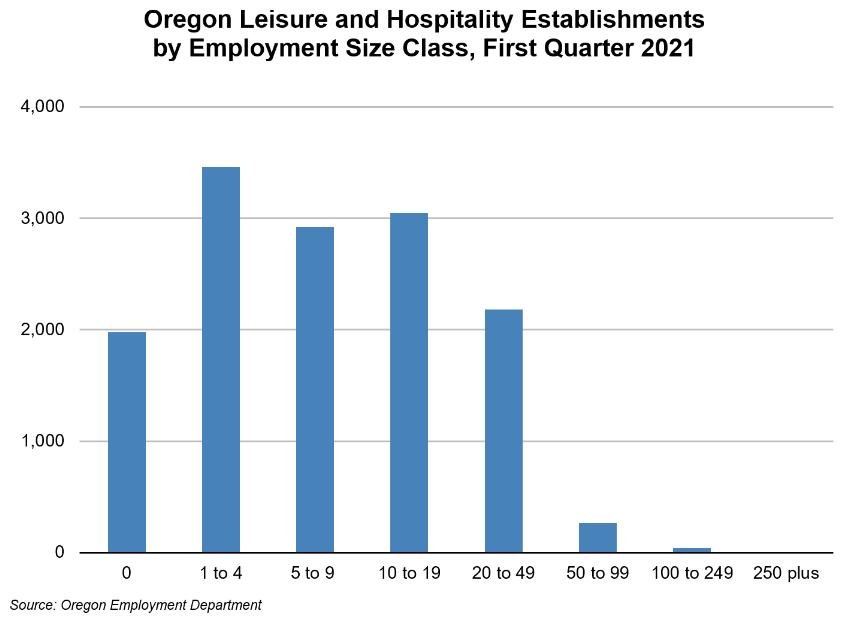
have been filled with usual summer travelers.
Connection to Tourism
We often think of leisure and hospitality as a tourism industry. While many jobs in this industry are reliant upon tourism, local spending also plays a significant role. The Oregon Tourism Commission contracts Dean Runyan Associates to produce travel spending impact analysis for Oregon. According to their Oregon Travel Impacts 1991- 2020 report’s preliminary estimates, travel spending generated 75,400 direct jobs in the accommodation and food services sector in 2019 and fell to 59,000 in 2020. In 2019 there were 20,600 direct jobs in the arts, entertainment, and recreation sector, which fell to 16,300 in 2020. Combined, these jobs made up about 82% of total direct travel-generated employment that year. Retail and wholesale trade, professional and business services, and transportation were other industries that had direct travel-generated employment in Oregon. While tourism is undoubtedly critical to the growth and success of many leisure and hospitality jobs, there are likely even more that depend upon local business and customers. Dean Runyan Associates’ most recent visitor volume and travel impact report can
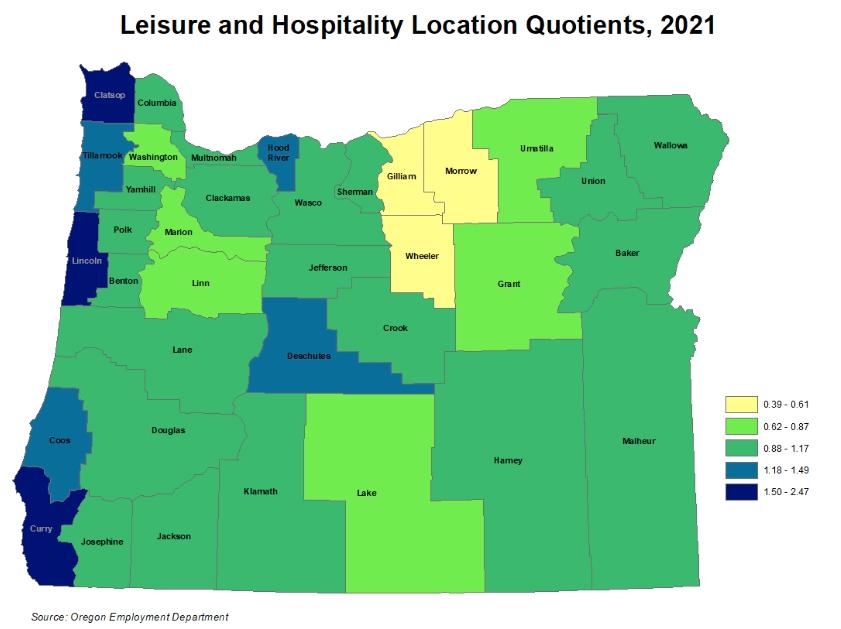
Leisure and Hospitality’s Sales and Share of Oregon’s Gross Domestic Product
According to the 2017 Economic Census, sales in Oregon’s accommodation and food services industry totaled $11.8 billion among 9,261 firms. Five years earlier, total sales in Oregon were just under $8.5 billion. The arts, entertainment, and recreation industry had $1.7 billion in sales among 1,362 Oregon firms in 2017. The Economic Census is only conducted every five years.
Oregon’s gross domestic product (GDP), the estimated value of all goods and services produced in the economy, is also estimated for the leisure and hospitality sector. The Great Recession drove leisure and hospitality industry GDP down 10% between 2007 and 2009. The industry fully recovered by 2012, with GDP totals above the pre-recession level and continuing to grow until 2019 when about $8.8 billion was generated in Oregon’s economy. With the growth in recent years, the relative share that leisure and hospitality contributes to Oregon’s overall economy has slowly risen from about 3.0% of total GDP in 1997 to
about 4.0% during the five years preceding the pandemic. In 2020, leisure and hospitality’s share of Oregon’s GDP fell to 2.8% and recovered slightly to 3.2% in 2021. Total leisure and hospitality GDP plunged to $6.0 billion in 2020, before rebounding somewhat to reach almost $7.1 billion on 2021, according to the Bureau of Economic Analysis.
Most Oregon Leisure and Hospitality Establishments Are Small
In Oregon, there were just 44 leisure and hospitality establishments that had 100 or more workers at the beginning of 2021. Size of establishment data are published for only the first quarter of each year, typically the slowest season for leisure and hospitality, so that may skew these values. An establishment may have no paid employees during the slowest winter months, and then bring on seasonal workers during the busier summer months. The greatest number of establishments had between one and four workers, and slightly fewer employed between 10 and 19 workers. Of Oregon’s 157,000 leisure and hospitality jobs in March 2021, 103,626 were in establishments with 10 to 49 workers.
Coast Most Dependent on Leisure and Hospitality
The coastal counties Clatsop, Lincoln, and Curry are the most leisure and hospitality dependent in Oregon, with more than twice the share of employment as in Oregon statewide. Other counties including Coos, Deschutes, Tillamook, and Hood River counties also have a strong concentration of leisure and hospitality jobs. The map displays the location quotients for the leisure and hospitality industry within Oregon. Location quotients are a measure of industry employment concentration. If a county has a location quotient of 1.0 that means its relative percentage of leisure and hospitality jobs compared with the allindustry total is the same share of employment in that industry as the statewide total. Oregon as a whole has a very similar concentration of leisure and hospitality jobs to the United States. Tourism hot spot counties such as Hood River and Deschutes have strong leisure and hospitality location quotients.
Conclusion
While below the prepandemic total, nearly 200,000 jobs can be found across Oregon’s more than 14,000 leisure and hospitality establishments. As the economy eventually recovers from the pandemic, we can hope that this industry recovers as well. Many Oregonians, including myself, started their careers working in restaurants. Those skills, such as getting along with coworkers, providing quality customer service and countless more, are essential and transfer to many other industries and jobs. Recovery from the pandemic will bring many opportunities to apply those skills, in Oregon’s leisure and hospitality businesses and beyond.



